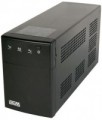Full load operating time
UPS continuous operation time from a fully charged battery when connected to a load with a power equal to the UPS output power (maximum or effective, depending on the type of load, see the relevant paragraphs for details). For a UPS designed to work with a home or office PC, a time of about 10-15 minutes is considered sufficient, this is enough to save data and complete work. To power servers, it is worth using devices with an operating time
of 20 minutes or more.
Input voltage range
In this case, the input voltage range is implied, in which the UPS is able to supply a stable voltage to the load only due to its own regulators, without switching to the battery. For redundant UPSs (see "Type") this range is quite small, approximately 190 to 260 V; for interactive and especially inverter ones, it is much wider. Some UPS models allow you to manually set the input voltage range.
Max. current
The maximum current drawn by the UPS. In fact, the current reaches its maximum value only when the UPS is operating from the mains with maximum load power and a completely discharged battery. However, when calculating the load on the power grid, this parameter should be taken into account.
Bypass (direct connection)
Bypass(by-pass) means such a mode of operation of the UPS, in which power is supplied to the load directly from an external source — the mains, diesel generator, etc. — practically without processing in the UPS itself. This mode can be activated either automatically or manually.
— The automatic bypass is a kind of safety measure. It turns on when the UPS in normal mode cannot supply power to the load — for example, when the UPS is overloaded due to a sharp increase in the power consumption of the load.
— Manual bypass allows you to enable this mode at the request of the user, regardless of the operating parameters. This may be necessary, for example, to hot-swap a battery (see below for details) or to start equipment that has a starting capacity greater than that of the UPS. Technically, it can also play the role of a security measure, but automatic systems are more reliable in this sense.
Some UPSs provide both options for enabling the bypass.
Battery hot swap
The ability to replace the battery directly during the operation of the UPS, without disconnecting it from the network and the load. To do this, the device is switched to bypass mode (see "Bypass (direct connection)") or, if there are more than one battery, it switches to another battery. The
hot-swappable battery is useful, for example, in the event of a battery failure, or to replace dead batteries with fresh ones if there is no time to charge.
Fuse
Fuses are used to protect the UPS from a critical increase in current strength: at the right time, they open the circuit, preventing unpleasant consequences. Today, these types of fuses are used.
— Melting. At a critical current strength, the conductive element in such a fuse melts and opens the circuit. The fusible protection is disposable, after operation such a fuse must be replaced.
— Automatic. Such a fuse has a sensor that monitors the current strength and opens the contacts at the right time. Its main difference from fusible is reusability: after operation, the circuit can be closed again with literally one press of the button on the fuse.
Screen
The presence of the UPS own
display makes management more convenient. Various operating characteristics can be displayed on the external screen: mains voltage and frequency, operating mode, load level, battery charge, bypass status, etc.
Noise level
The maximum noise level produced by the UPS during operation. A noise of 30 dB approximately corresponds to a loud whisper, 40 dB to a conversation at a distance of several metres (it is models up to 40 dB that can be considered
quiet UPS), 50 dB is considered the maximum noise level that does not create discomfort. The redundant power supplies are the least noisy, and inverter power supplies are the noisiest (see "Type"). In general, the lower the noise level, the more comfortable the use of the UPS, however, for devices installed in offices where people do not stay permanently (for example, server rooms), this parameter is not critical.

